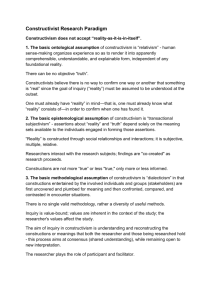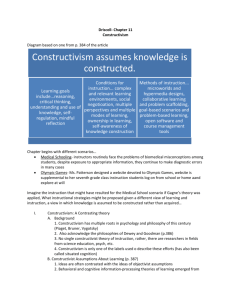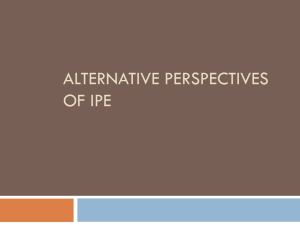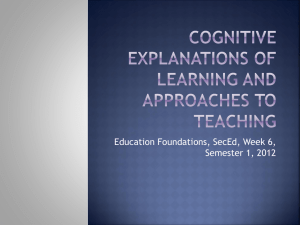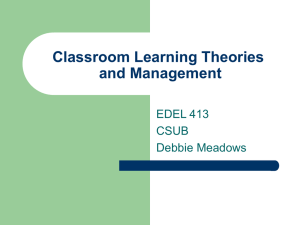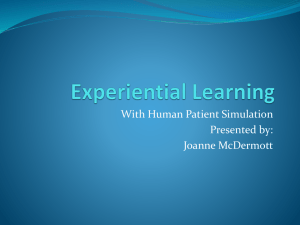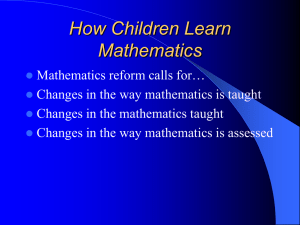ConstructivismInstructional Design
advertisement
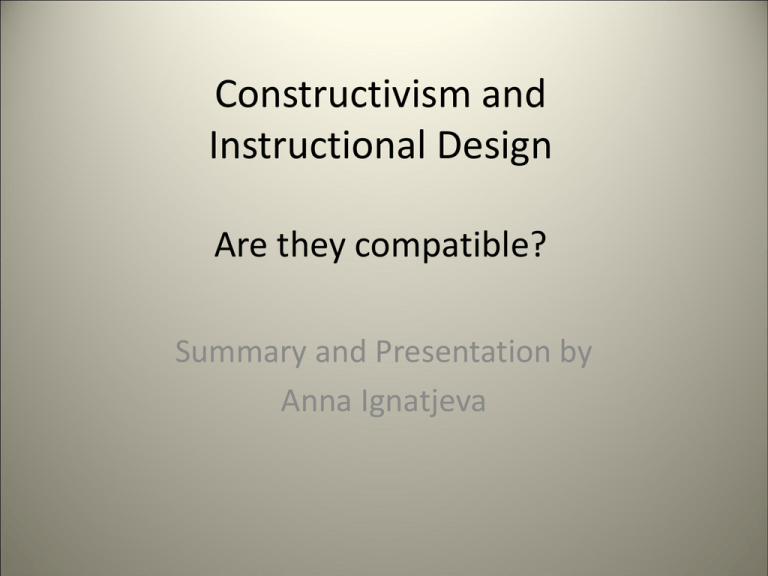
Constructivism and Instructional Design Are they compatible? Summary and Presentation by Anna Ignatjeva Introduction • Instructional designers use various theories. • Constructivism has been dominant theory of last decade. • This presentation addresses the following: – Basic principles of constructivism – Implications of constructivism on instructional design Constructivism-an overview • Constructivists believe that learners actively create knowledge based on their own experiences, goals and beliefs. • Concepts of “Teaching” and “Learning” not synonymous. • Knowledge cannot be transferred but only constructed. • Meaning is created by individual not imposed on individual. Constructivism in video Click on the link below to learn more general information about constructivism theory in education http://www.youtube.com/watch?v=F00R3pOXz uk Two groups of Constructivists • Radical constructivists • Non-radical or moderate constructivists Implications for Instructional Design My research presents constructivism in terms of three major phases of instructional design Analysis Development Evaluation Analysis • Traditional Approach- analyze who is the learner, content and setting. • Constructivist Approach- does not break environment into traditional components; no predetermined content or tasks. • Constructivists analyze learning environment as whole and provide rich context to negotiate meaning. Development • Traditional Approach- set and achieve specific performance objectives. • Constructivist Approach-no predetermined content and objectives. • Constructivists concentrate on studentcentered, student directed, collaborative, supported and cooperative learning. Development cont There are 4 major strategies preferred by constructivists in this stage 1. Active Learning 2. Authentic Learning 3. Multiple Perspectives 4. Collaborative Learning Evaluation • Traditional Approach-evaluate the outcomes and results of learning. • Constructivists evaluate thinking process, metacoginitive and reflective skills. • Constructivist learners need to explain what they have learned and make connection to previous experiences. Challenges • Pre-specification of knowledge • Evaluation • Learner Control • Underlying philosophy not a strategy Solution based on Merrill’s second generation instructional design theory – Mental models are constructed by learners based on their experience – Each mental model may be different, but their structure is the same – Teaching authentic tasks in a context is desirable – But there is also need to teach abstractions that are taken out of context – Subject matter and instructional strategy are somewhat independent – But both of these can be adapted to different contexts separately, if needed – There is class content that is appropriate for all learners – When learning is active not necessarily collaborative, an individual learning is as effective – Testing can be incorporated and aligned with learning objectives – But other type of assessment is also possible (Karagiorgi & Symeou, 2005 p.23). Technology tools • Hypermedia, multimedia and Internet can allow for non-linear learning with increased learner control. • Toolkits, coaching, scaffolding, role-playing games, simulations, case studies, storytelling promote active constructive learning. • In the future micro worlds and virtual reality can simulate authentic learning. Conclusion • Constructivism can become guiding theoretical foundation of the future. • Two issues to consider: – Moderate not extreme constructivism fits into instructional design framework – Many new technologies can implement and facilitate constructivist environments. Go to Journal of Educational Technology and Society online to read more http://www.ifets.info/journals/8_1/5.pdf References • Gordon, M. (2009). Toward A Pragmatic Discourse of Constructivism: Reflections on Lessons from Practice. Educational Studies, 45, 39–58. • Karagiorgi, Y., & Symeou, L. (2005). Translating Constructivism into Instructional Design: Potentials and Limitations. Educational Technology & Society, 8 (1),17-27. • Kafai, Y., & Resnik, M (1996). Constructionism in practice: Designing, thinking and learning in a digital world. Mahwah: Lawrence Erlbaum. • Spiro, R. J., & Jehng, J. G. (1990). Cognitive flexibility and hypertext. In Nix, D. & Spiro, R. (Eds.), Cognition, education, multimedia, New Jersey: Lawrence Erlbaum, 165-202. • Von Glasersfeld, E. (1995). A constructivist approach to teaching. In Steffe, L. P. & Gale, J. (Eds.),Constructivism in education, New Jersey: Lawrence Erlbaum, 3-15. • Neo, M., & Neo, T.-K. (2009). Engaging students in multimedia-mediated Constructivist learning – Students’ perceptions. Educational Technology & Society, 12 (2), 254–266. • Kala, S. et. al (2009).et al. Electronic learning and constructivism: A model for nursing education. Nurse Education Today. Retrieved on October 12, 2009 from www.elsevier.com/nedt Questions?



